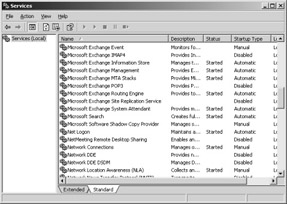Verifying Your Installation
You’ve installed Exchange Server, but don’t pat yourself on the back just yet. You still need to perform some basic postinstallation tasks to make sure everything is running well. The first thing you should do is restart your server. After you’ve done so, check the Windows event log for any problems. Each Exchange component that makes up your new server runs as Windows services. You can verify that these services are running by using the Services tool, available from the Administrative Tools folder on the Start menu. Figure 7-9 shows the Services console window. You should see the following services listed:

Figure 7-9: The Services console window.
-
Microsoft Exchange Event
-
Microsoft Exchange IMAP4
-
Microsoft Exchange Information Store
-
Microsoft Exchange Management
-
Microsoft Exchange MTA Stacks
-
Microsoft Exchange POP3
-
Microsoft Exchange Routing Engine
-
Microsoft Exchange Site Replication Service
-
Microsoft Exchange System Attendant
Depending on the optional components you installed with Exchange Server 2003, you might also see several other Microsoft Exchange services running.
Microsoft releases service packs for Exchange Server 2003, just as it does for Windows. To avoid possible problems later on, it is best to install the latest available Exchange Server 2003 service pack. See the “Getting Service Packs” section earlier in this chapter for more information. If you are concerned about the latest service pack introducing new problems (and they often do), consider testing the service pack on a nonproduction server first. After you’ve installed the service pack, you should restart the system again. When the server is back on line, check the Services console window again to ensure that the Exchange Server services are up and running. Your new Exchange server is ready to be configured. Now you can pat yourself on the back. And now that you’ve installed Exchange Server 2003, you’re ready to apply the other software you need to integrate your Exchange environment, such as third-party backup software, virus-detection utilities, or content filtering applications.
| Note | To verify that services are running on a remote Exchange Server, you can use the Connect To Another Computer feature of the Computer Management snap-in. You can also use server monitors to keep watch over services for you in the Exchange System snap-in. You’ll learn how to set up these monitors in Chapter 26, “Monitoring Exchange Server 2003.” |
One of the first things you might be tempted to do after successfully installing Exchange Server 2003 is poke around the system to see what was put where. This is fine, of course, and it’s a great way to learn more about how Exchange is laid out.
EAN: 2147483647
Pages: 254